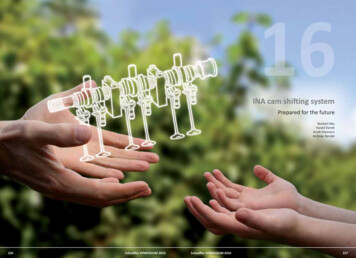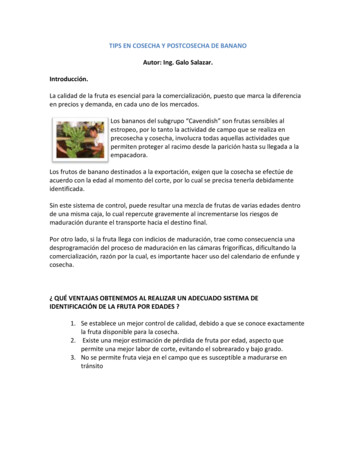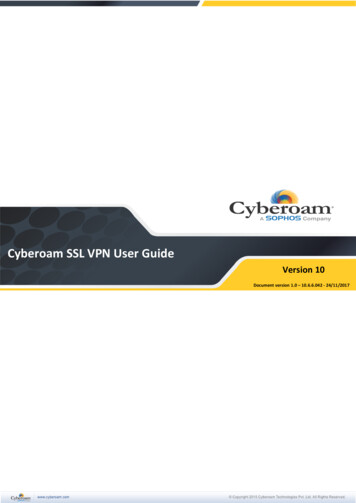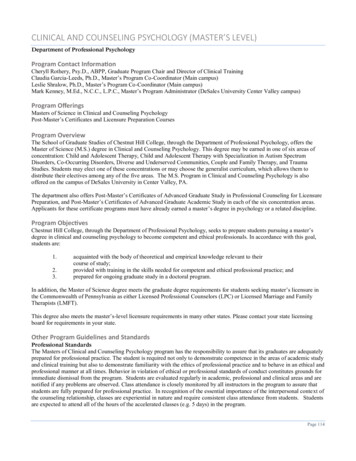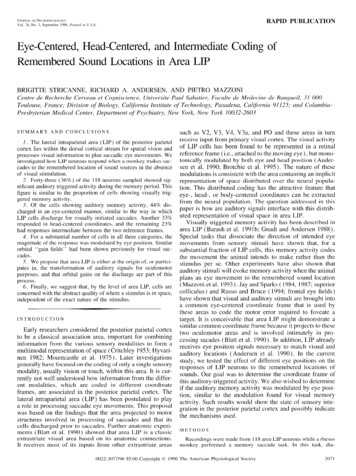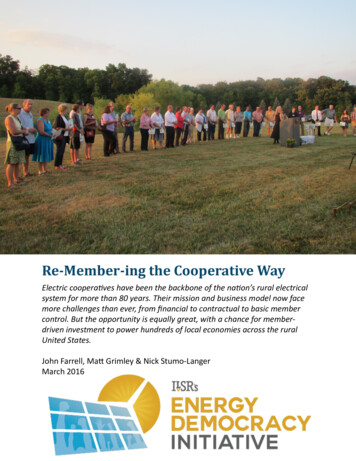
Transcription
Re-Member-ing the Cooperative WayElectric coopera,ves have been the backbone of the na,on’s rural electricalsystem for more than 80 years. Their mission and business model now facemore challenges than ever, from financial to contractual to basic membercontrol. But the opportunity is equally great, with a chance for memberdriven investment to power hundreds of local economies across the ruralUnited States.John Farrell, Ma- Grimley & Nick Stumo-LangerMarch 2016
ectric-cooperative/Report: Re-Member-ing the Electric Cooperativeby John Farrell, Matt Grimley & Nick Stumo-LangerElectric cooperatives have been the backbone of the nation’srural electrical system for more than 80 years. Their missionand business model now face more challenges than ever,from financial to contractual to basic member control. But theopportunity is equally great, with a chance for member-driveninvestment to power hundreds of local economies across therural United States.Download the ReportExecutive SummaryElectric cooperatives face diverse challenges, from their power sources to member engagement. This report detailsthose challenges and the tools that cooperatives are using to overcome them.The ChallengesTied to Coal PowerCoal accounts for about 75% of energy generated by electric cooperatives, compared to just 32% for the UnitedStates’ entire electricity sector (U.S. Energy Information Administration, 2016).Captured in Long-Term ContractsContracts with electricity suppliers extend for decades, sometimes past 2050, trapping locally-based electriccooperatives into increasingly expensive distant power plants and fossil fuel sources, while forbidding them from1/19
buying outside energy.Losing Member-Owners.Electric cooperative members have a right to vote for their boards of directors. But 70% of cooperatives have lessthan a 10% voter turnout, increasing the disconnection between the cooperative and its members.The SolutionsFortunately, the solutions lie in the best of the cooperative movement.Finding Ways Out of Coal PowerA new ruling from the U.S. Federal Energy Regulatory Commission may allow electric cooperatives to purchase localpower outside their contractual obligations, providing a novel level of flexibility for most cooperatives.Using Clean Energy and On-Bill FinancingElectric cooperatives are finding new ways to enable energy savings for member-owners. They’re leaders inexperimenting with community solar. A few are supporting the highest penetrations of rooftop solar in the nation.They’re creating cost-effective on-bill financing programs that help members save energy and money.And Empowering Member-OwnersThe member-owners of Pedernales Electric Cooperative, Beartooth Electric Cooperative, Jackson EnergyCooperative, and many others have made their cooperatives more accessible, more dedicated to renewable energyand energy efficiency, and more democratic than ever.Cooperatives may face their greatest challenge since the inception of rural electrification inthe 1930s, but with their members, they have the power to overcome.Table of ContentsAcknowledgementsIntroductionThe Challenges1. Coal-Powered, Under Fire2. A Contract Job3. Missing MembersThe Opportunities1. Local Renewables Beat Dirty Power2. Energy Savings at Home3. Restoring Democracy2/19
A Cooperative FutureRecent ILSR PublicationsFootnotesAcknowledgementsThank you to all the cooperative board members, member-owners, and advocates for help and review. Thanks toRebecca Toews and Nick Stumo-Langer for making sure more than 5 people read it. All errors are our ownresponsibility.Contact John Farrell (jfarrell@ilsr.org) and Matt Grimley (mgrimley@ilsr.org) with questions.IntroductionDecades after cities lit the first electric lamps in the 1880s, most of the rural places of America were still dark. Urbanutilities didn’t care for the expense of wiring farms, and it wasn’t until communities organized that electricity expandedto rural areas. Farmers in southwest Idaho, for example, formed a nonprofit in 1920 to build 256 miles of power linesto transfer power from a federal hydroelectric dam.1 In 1923, farmers near Granite Falls, Minn., made a cooperativeto buy power from a nearby municipal utility. By 1930, there were 46 cooperatives in 13 states, but many still facednatural and economic obstacles, as well as opposition from investor-owned power companies.In the 1930s, President Franklin Roosevelt launched numerous government program to combat the Great Depressionand encourage economic growth. In 1935, he created the Rural Electrification Administration. The agency wouldprovide long-term, 2% loans to nonprofit public entities to deliver affordable electricity across the nation. Within 6years, there were 800 electric cooperatives in the United States, driven by member-owners that bought the sameenergy they produced collectively.2Today, more than 900 electric cooperatives serve 42 million (mostly rural) Americans. These cooperatives cover 75%of the nation’s land mass. They deliver 11% of U.S. electricity sales on a network containing 42% of its of itsdistribution lines.3/19
Image Source: NRECA 3Cooperatives have been the backbone of the nation’s rural electrical system for more than 80 years. Their missionand business model now faces more challenges than ever, from financial to contractual to basic member control. Butthe opportunity is equally great, with a chance for member-driven investment to power hundreds of local economiesacross the rural United States.The ChallengesElectric cooperatives face diverse challenges. They rely heavily on coal power, with rising costs and risks as thenation eyes limits on carbon emissions. They are tied to this dirty and increasingly expensive power throughownership of coal assets (including power plants and mines) and by long-term purchase contracts, even as distributedsolar, wind power, and energy storage are becoming more cost-effective. They serve 90% of the nation’s countieswith “persistent poverty.”Perhaps the largest barrier is the lack of member participation. As the National Rural Electric Cooperative Association(NRECA) wrote in its paper, “The Electric Cooperative Purpose,” the electric cooperative is not defined by its productsand services. Its “bottom line” is the empowerment of its member-owners. How it engages its membership to deal withthe problems of the 21st century will define its success or failure. In many electric cooperatives, members do not evenknow they are owners, and fail to participate.Coal-Powered, Under FireThe “distribution” electric cooperatives that sell power to customers don’t typically generate it themselves. They buy it,typically from generation and transmission cooperatives (G&T) that are owned by distribution cooperatives, or fromfederal power agencies, such as the Tennessee Valley Authority.The generation and transmission cooperatives — the co-ops of co-ops — derive 75% of their energy from coal, andcomprise 7 out of the 10 most carbon-intensive electric utilities in the nation (below, annotated by ILSR to denote G&T4/19
cooperatives).4Image Source: Climate Desk 5The trends that precipitated the cooperatives’ tie to coal include factors both in and out of their control.As electric demand was expected to continue increasing almost exponentially in the 1960s and ‘70s, the drive towardeconomies of scale led the energy industry, mostly under the direction of investor-owned utilities, to construct largerand larger power plants. Many electric cooperatives banded together (in G&T cooperatives), and either sought tobuild their own large power plants, or were lobbied hard by the investor-owned utilities to buy a share of theirs,utilizing low interest financing through the Rural Electrification Administration to help fund the project.Additionally, during the 1970s and ‘80s, under threat of oil and gas scarcity, the federal government sought to limit5/19
natural-gas fired power plants and incentivize coal-fired power plants. Most utilities shifted their power plant builds tocoal-fired or nuclear power plants. Today, as cooperatives and other utilities have continued to build and retrofit coalplants, about two-thirds of current cooperative generation remains from coal.With looming carbon regulations, increasing consumer demand for rooftop solar and energy efficiency, and thecompetitive growth of cheap wholesale energy from wind, natural gas, and solar, G&Ts now face “stranded assets,” orhaving to retire uneconomical coal plants and their upgrades before they are completely paid off. For example,Seminole Electric, which rounds out the top 30 of carbon-intense utilities, says that 75% of its debt comes frombuilding and retrofitting a single coal-fired power plants.6 Closing the facility would leave member cooperatives“burdened with paying off the debt but with no revenues to support the payments.”In the face of economic challenges, NRECA and its electric cooperatives continue to fight against most federal andstate rules that endorse clean energy or energy efficiency, or require a fair accounting of environmental and healthcosts from fossil-fueled generation.7 Some cooperatives still say climate change in quotes.8 In all, electriccooperatives engaged more than 1 million members to send in comments in opposition to the U.S. EnvironmentalProtection Agency’s proposed carbon rules.9 One cooperative in Ohio supported the effort by collecting 2,246comments from its members, more than twice the members that usually turn out for yearly board elections.10Distribution cooperatives and members are now burdened with decisions made by their boards and managementdecades ago. Members today are between a rock and a hard place: running a coal-fired power plant is increasinglyexpensive, or seeing rates rise if they decide to shutter the power plant. As NRECA says, it will ultimately be thedistribution cooperatives that face the member-owners’ ire, “and without proper management, the very existence ofmember-owned cooperatives could be in jeopardy.”11A Contract JobAs mentioned previously, Electric cooperatives rarely supply their own power. According to NRECA, 65 to 70% comesfrom commitments secured through “all-requirements” contracts.All-requirements contracts are used to protect the power supplier, G&T, or federal power agency from contractdefault. They restrict the electric cooperative from buying from outside sources. The G&T can set rates unilaterally,meaning that while electric cooperatives have a guarantee of power, it is not a guarantee of low cost power.To say the balance works out in the supplier’s favor is an understatement. Rating agency Standard and Poor’sexplains this in an evaluation of a Seminole Electric.12 One of the utility’s credit strengths is, “A captive retail marketand the ability to set rates through take-and-pay, all-requirements wholesale power agreements with nine of 10members through 2045.”In New Mexico, the Kit Carson Electric Cooperative signed a long-term contract with Tri-State Generation andTransmission Association (a G&T) in 2000, a decision many now regret.13 Power costs then were about 3.6 cents perkilowatt-hour. While wholesale power costs are now 4 cents per kilowatt-hour, Kit Carson’s costs from Tri-State haverisen to 8 cents per kilowatt-hour. Because Kit Carson’s all-requirements contract to purchase 95% of their energyfrom Tri-State, they cannot seek cheaper energy without violating the terms of the contract.Kit Carson sought to exit their contract in the last year. Tri-State initially said it would require a 132 million exit feefrom the cooperative, representing lost sales from Kit Carson’s departure. After negotiation, Tri-State latered loweredthe exit fee to 37 million, and Kit Carson is deliberating how to move forward.According to another NRECA publication, those electric cooperatives with all-requirements contracts “are generallyprohibited from owning and using any utility-scale solar PV installation.”14 Elsewhere, the contracts block distributionelectric cooperatives from purchasing energy from other suppliers, even small ones. The Delta-MontroseElectric Association was recently stopped by Tri-State’s 95% energy requirement from purchasing energy from a6/19
local hydroelectric facility.15The situation is rather ironic, since Tri-State — like most G&T cooperative utilities — is owned by its distributioncooperatives like Kit Carson. In the past era of ever-rising electric demand, massive economies of scale in powergeneration, and few power supply alternatives, the G&T was a way to make the many small cooperatives competitive.But now, with flat or falling electricity use, smaller economies of scale with renewable energy, and competitive localalternatives, the bonds of solidarity have become more like chains.Missing MembersRandy Wilson ran for the board of the Jackson Energy Cooperative in 2009, the first candidate to contest an electionin the cooperative’s 71-year history.16 He ran on a platform of financing energy efficiency improvements on theelectricity bill (known in energy policy circles as on-bill financing), and moving the local economy past its dependencyon coal to alternative energy sources like solar.He spoke on the local radio show, appeared on the front page of the newspaper, and talked with other memberowners in parking lots. But Wilson wasn’t surprised that he lost the election 740 votes to 151.Less than two percent of members turned out to vote, but many more votes were cast with the use of “proxy” votes.Mostly used at corporate shareholder meetings, proxy votes allow one member to delegate his or her voting ability toanother member. In the case of Wilson and Jackson Energy, the electric cooperative had collected hundreds of proxyvotes from its members, then handed them to other members present at the annual meeting, telling them to vote asthey saw fit (meaning, for the incumbent).According to research from ILSR, Wilson’s story of low voter turnout was not unique. More than 70 percent ofcooperatives have voter turnouts of less than 10 percent (including Wilson’s Jackson Energy Cooperative, whichaverages just under 3 percent turnout).7/19
Image Source: ILSRThe low voter turnout at so many rural electric cooperatives is an indication of a member-owner apathy,disenfranchisement, and — in a few cases — outright abuse. Barriers around incumbency, burdened with difficult-toaccess meetings, elections, and voting requirements, are often too much for members to overcome, even if theywanted to.“Most electric co-ops are boys’ clubs that re-elect the same people, that develop policies that favor their children ortheir buddies,” says Tom “Smitty” Smith of the consumer rights advocacy nonprofit Public Citizen. Most states, Smittyadds, still believe in the myth of member-led rule and don’t regulate electric cooperatives at all. Colorado passedlegislation to democratize electric cooperative bylaws in 2010, but Texas’s similar efforts fell short after intenselobbying from the cooperatives.17The following map illustrates state electric cooperative regulation as of 2008.8/19
Image Source: ILSRBoard members and electric cooperative employees are aging, representing another needs where membership canhelp fill in the gaps at the cooperative.18 According to Kauai Island Utility Cooperative board chair JanTenBruggencate, “it would be convenient to believe that turnout is low because people believe we’re doing a goodjob Higher voter turnout gives directors indication of which platforms are resonating with those members. It can beused to provide strategic direction for the cooperative. An engaged membership will recognize threats to thecooperative, and help bring resources to bear to solve problems.”The OpportunitiesCooperatives across the nation are showing how to rely on each other and their members to create community-centricinstitutions that can overcome long-term reliance on dirty power sources and member disengagement.Local Renewables Beat Dirty PowerWith a recent ruling, the Federal Energy Regulatory Commission may have recently crashed one of the biggest gatesto the cooperative clean energy party.19 For years, cooperatives have been hitched to wagon of large, coal-firedpower generation through all-requirements contracts.A few, like Delta-Montrose Electric Cooperative and other cooperatives went looking for local energy options. Unableto get resolution in direct negotiation, Delta-Montrose took Tri-State to the Federal Energy Regulatory Commission.9/19
The request was relatively simple: tell Tri State that it’s required to allow Delta Montrose to buy power from aproposed local hydroelectric power plant, even if it takes a bite out of their contract with Tri-State.Although FERC didn’t accept Delta-Montrose’s rationale, they did accept their conclusion.In requiring electric utilities to purchase renewable power from “qualifying facilities,” FERC said that the 1978 federalPURPA law supersedes the cooperative’s contract.20,21 Delta Montrose must purchase power from small renewableenergy facilities in their service territory, and pay at least their own “avoided cost” of energy, e.g. the cost of the energypurchases avoided by the purchase from the qualified PURPA facility. This is a contested issue, with many utilitiesasserting that this is simply their wholesale cost to purchase a marginal kilowatt-hour of power. On the other hand, aFERC ruling in 2010 allowed that states could set avoided cost rates by technology, on the basis of the differingvalues of the renewable resources.22 FERC allowed that Delta Montrose could negotiate a power purchase rate.The FERC ruling doesn’t allow Delta Montrose to develop more of its own clean energy resources outside itscontractual limits, nor does it change where they get the balance of their energy supply: from Tri-State.FERC noted two potential exceptions to the ruling that did not apply to this particular case. Some distributioncooperatives have transferred their PURPA purchase obligation to their wholesale supplier. In that case the powergenerator would have to sell to the wholesale supplier (e.g. Tri-State). Some utilities have received a waiver from theirpurchase obligation under PURPA, but only if there’s a competitive marketplace available for the generator to sell intoother than the utility, an unlikely scenario for most cooperatives.23Tri-State is now requesting FERC that it be allowed to levy a fee on Delta-Montrose for any lost revenues from thecooperative purchasing outside its contract. If they succeed, it will undermine the economics of buying local power forDelta-Montrose. 24 However, FERC has opened the door for distribution cooperatives to purchase local power outsidetheir contractual obligations, providing a novel level of flexibility.Energy Savings at HomeSeveral cooperatives are adapting to the new era by bringing energy efficiency and renewable energy closer to homewith the help of a federal program, and even a few cooperative ventures of their own.The USDA’s Rural Utility Service’s Energy Efficiency & Conservation Loan Program allows rural utilities to borrowmoney at low rates – over 30 years at 3.3% – for energy efficiency and renewable energy improvements at theirfacilities or properties owned by customer-members it serves. The obligation to pay can be tied to the meter, allowingthe energy savings and the financial obligation to pass from owner to owner of the property.The bill-based financing can be particularly powerful at reaching disproportionately low-income cooperative membersbecause the financing can be secured by the projected energy savings rather than a member asset (such as theirhome). It can also be provided without credit scoring that typically eliminates most low-income households fromparticipation.In 2014, the Rural Utility Service authorized as much as 6 billion in loans in 2015. What could 6 billion buy? 25 6 Billion for Rural Energy Effici
The member-owners of Pedernales Electric Cooperative, Beartooth Electric Cooperative, Jackson Energy Cooperative, and many others have made their cooperatives more accessible, more dedicated to renewable energy . and the ability to set rates through take-and-pay, all-re






